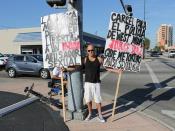Psychology of Terror PSC 3900 According to the Social Dominance Theory, those attached to a subordinate group are prosecuted, and when found guilty, imprisoned at greater rates that their dominant group counterparts. Among the groups found in the subordinate groups are the blacks and Hispanics in North America, Arabs living in Israel, Aborigines in Australia, and the foreign born in Europe.
Illustrating a brief piece of Americana, in California, five times as many blacks are in prisons as are in college. Forty percent of black males between 18 and 30 are involved with the Probation Department, the Parole Board or the prison system. Over sixty percent of blacks between 18 and 30 have or will be arrested. In the District of Columbia, half of black American males are targets of the criminal justice system. In the years between 1980 and 1992 black inmate population increased steadily year after year.
Law is an expression of the common good according to the value consensus model. That is, the dominant group determines what is good for society and forms laws to keep society from operating outside those laws they have deemed "good." Those in power put the idea that law is an expression of the common good forward. Then the pluralistic model suggests that the values protected, serve the interest of the dominant groups. A third model used to explain why the dominant social theory exists and persecutes minorities or subordinates is the class conflict model. In this model, the law is used not only to forward the interests of the dominant group, but also to oppress, restrain and control the subordinate group.
The law serves to maintain this group based social order with actions to suppress threats to the dominant group. In the search for true happiness in the dominant group, terror is a helpful tool. There are three types of terror, official terror, semi-official terror and unofficial terror. Official terror is legally sanctioned violence carried out by security forces and the justice system. Examples of official terror in history are the persecution of Jews in Germany pre, and during World War Two, the repression of Shiites in Iraq, apartheid based executions in South Africa. A veiled form of official terror occurring in the United States was the Drug Abuse Act of 1988 wherein harsher punishments were meted out in drug violations some that did not include anything but the personal use or abuse of controlled substances. Because of the nature of the law, it is seen as targeting street drug users, many of whom would fall into the subordinate groups Semi-official terror is violence that is organized, but not sanctioned by the state or regular law. Cointelpro is a prime example in the United States. Cointelpro was the FBI's secret program to undermine the popular upsurge which swept the country during the 1960s. Though the name stands for "Counterintelligence Program," the targets were not enemy spies. The FBI set out to eliminate "radical" political opposition inside the US. When traditional modes of repression (exposure, blatant harassment, and prosecution for political crimes) failed to counter the growing insurgency, and even helped to fuel it, the Bureau took the law into its own hands and secretly used fraud and force to sabotage constitutionally- protected political activity. Its methods ranged far beyond surveillance, and amounted to a domestic version of the covert action for which the CIA has become infamous throughout the world. Another example is the death squads of South America in the 1970's and 80's.
Unofficial terror lacks implicit or explicit support and is carried out by individuals. The list of unofficial terrorists is long, and includes the KKK, ethnic extremists in the former Yugoslavian provinces, and the likes of Theodore Kaczynski and Timothy McVeigh.
In the systems of justice, a group of laws of law provide official terror for the dominant group and its interests. There are five laws in the group.
The first rule is when laws are violated, the punishment will be harsher toward subordinates than dominants, or the disproportionate prosecution principle.
Next is the out of place principle, or when subordinates are accused of acts of violence toward dominant group members, the penalties will be extremely harsh.
The third law is the social role congruency principle. Stated simply, this fits round pegs into the round holes. Within the criminal justice system, the level of social dominance orientation will be greater or high among those with hierarchy enhancing roles, i.e. the police and prosecution team, and the social dominance orientation will be lower among those playing the role of hierarchy attenuator, i.e. the defense counsel.
Law number four is the tolerance of abuse principle. The degree of punishment when levied against agents of the state for abuse of power will be small, especially in cases of abuse toward subordinate groups. This is merely protection of the people who protect the dominant group. Security officers abusing power will not be severely punished.
The last of the five laws of law is the hierarchy-terror principle. This law states that the greater the degree of social hierarchy, the greater the use of formal and informal terror there will be.
So, all of this just cements the hierarchy where it is. The plight of American inner cities is at least usually a dabbling into some non-social behavior, whether it is drinking at a young age, drug abuse, and petty or not so petty crime. To blow it off as a role of the dice I think would be to remove my mask of social dominance orientation. But, from far above on the perch, it is just that. If a young man, who comes from a less than opportune background, makes it through those years of disenchantment without a brush with the law, he is a minority within the minority.
For those who do brush up against the law, the odds are stacked in their disfavor. There certainly is a double or maybe triple standard in the justice systems, I can't say especially in America, but it absolutely exists here. The subordinate, many times a minority, is seen by much of the criminal justice system as a losing cause the first time he enters the system. If his crime is against someone else, not from the street, (a dominant), he is a violent, and I would say at times, he is considered a bully. He uses his street wit and physical toughness, whether personal physical toughness, or the strength in numbers or weapons, and beats on a civilized person. For this, the punishment is greater; the probability of conviction is greater.
In merely abandoning his plight in life through the use or abuse of alcohol or drugs, many subordinates are outside of the constitutionally protected homes. This makes them an easier target for law enforcement and due to their inability to buy better than decent legal counsel incarcerations are longer. This is not to mention the fact that judges and jurors, who may be dominant have a, "There but for the Grace of God go I." attitude.





